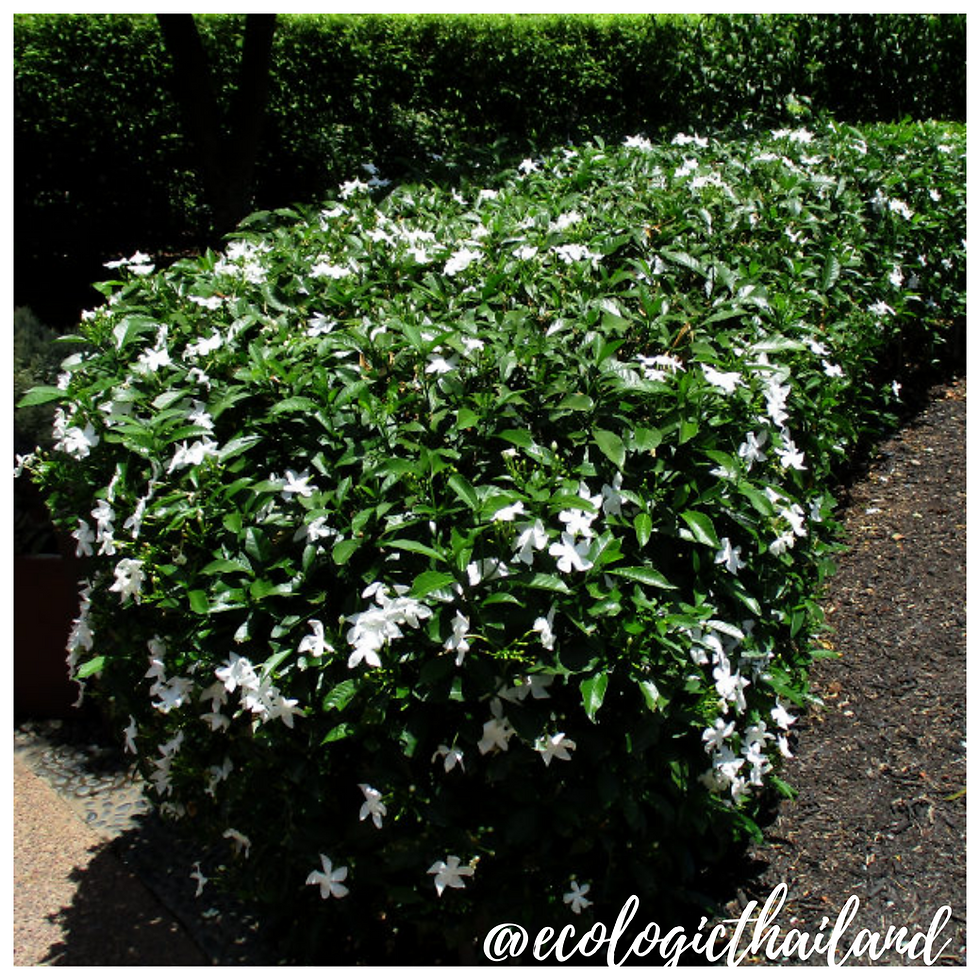Blue Trumpet Vine | Laurel Clock Vine
- Eco-Logic Resort
- Mar 6, 2021
- 3 min read
Ran Jeud | รางจืด | Thunbergia laurifolia
Family: Acanthaceae - Genus: Thunbergia

The Blue Trumpet vine can be found near the entrance of the Foundation. It grows wild into the trees alongside the road.
A vigorous, hairless, woody vine with tuberous roots, climbing by twining stems and reaching a length of 12 meter or more in one season. The vine has showy violet, white or blue trumpet-shaped flowers. It is also know as laurel clock vine, blue trumpet vine, laurel-leaved thunbergia. Rang-Jued (Thai).
In Thailand, leaves are used as an antipyretic, as well as for detoxifying poisons.
The plant flowers almost continuously throughout the year with flowers opening early in the morning and aborting in the evening of the same day.

THE PLANT
Blue trumpet vine is a perennial climbing plant with stems up to 12 meter or more that scramble over the ground or can twine high into the surrounding vegetation.
The plant is sometimes harvested from the wild for local use as a food and medicine. It is commonly grown as an ornamental, being valued especially for its large, violet or white flower. The plant develops a very tuberous root system.

THE LEAVES
The leaves are opposite, heart-shaped with serrated leaf margin and taper to a pointed tip. Hairless, usually two to four times as long as they are wide. Lower half of the leaf sometimes irregularly lobed.
In Thailand and Malaysia, the leaves are dried and crushed and drunk as a medicinal tea.

THE FLOWERS
The petals of the Blue trumpet vine are joined at base to form a short, broad tube with a yellowish throat, opening out into five rounded, lavender to blue (occasionally white in the wild) petals.
Flowers are borne on hanging racemes (bearing four or more individual flowers) that can grow up to 1.8 m long.
CULINARY USES
The leaves of the Blue Trumpet Vine can be cooked and eaten as a vegetable.
TRADITIONAL MEDICINAL USE
NOTE: please take advice from a doctor if you are planning to use herbal medicine.
Internal Application: In the Thai tradition, the plant is most commonly used as a detoxifying agent. The leaves and stem purify the blood, and are therefore used as an antidote to all kinds of poisonous foods or chemicals. Some Hill Tribes prescribe it for poisonous snake or insect bites. Its detoxifying properties make it the preferred treatment for hangovers, and it is taken daily to counter the cirrhosis (inflammation of the liver) associated with alcoholism.
It is useful in treating indigestion, flatulence, diarrhea, mucus or blood in the stool, and intestinal parasites. It is also prescribed as a remedy for fever, allergies, and asthma, and is recommended for diabetes and hypoglycemia as it reputedly controls blood sugar levels.
This plant is mentioned in the Wat Pho texts as a remedy for vomiting in infants, blocked or irregular menstruation, gonorrhea, sores on the tongue and mouth, as a diuretic, and as a poultice for burns. Thunbergia laurifolia has been found effective in countering minor allergic reactions and intolerances (such as to MSG, alcohol, and so on). Recent research at Chiang Mai University also shows it to be promising in assisting farmers who are exposed to high levels of herbicides and pesticides.
External Application: Topically, the whole plant is ground and used as a poultice for snake bites. While not generally available in the West as an herbal medicine, Thunbergia laurifolia is sold as an ornamental plant, so those wishing to obtain it can do so relatively easily.
CAUTION :Thunbergia laurifolia, as an antidote to poisons, cleans the blood extremely effectively. Because of this, it is contraindicated for people who take life-sustaining medications, as it will purify even that out of the blood.
INTO THE WILD: a down to earth experience

For guests and visitors to Paksong we organize weekly tours "The Edible Forest" and Foraging weekends: Into the Wild. We work with local guides to take you in the jungle of Paksong. After foraging, we will cook a meal with the ingredients, using bamboo together with you!
Come and join and learn about the abundance of food that nature gives us!
INTO THE WILD!


















Comments